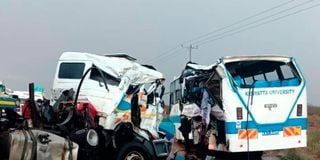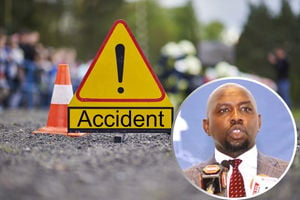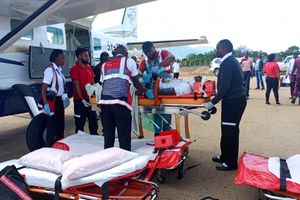
The wreckage of vehicles in a road crash involving a Kenyatta University bus and a truck at Maungu area on the Nairobi-Mombasa highway. The crash claimed the lives of 11 students.
Failure to ensure proper inspection of vehicles, rogue drivers, poor road designs, bribery and general poor enforcement of traffic laws are the main culprits of the rising number of fatal accidents.
So far this year, the National Transport and Safety Authority (NTSA) says over 700 Kenyans have died in road accidents, adding onto at least 36,000 persons lost in 70,000 road accidents over the past decade, according to the Kenya National Bureau of Statistics.
With pedestrians and motorcycle users constituting more than two-thirds of the deaths on Kenyan roads, the spotlight is yet again turning on State agencies mandated with ensuring safety on the roads, even as different players in the transport sector point to varied causes for the sorry state of affairs.
Appearing before Parliament this week, Interior Cabinet Secretary (CS) Kithure Kindiki noted that 4,608 Kenyans were involved in 1,926 road accidents in January and February alone, out of whom 763 died.
Prof Kindiki said 22,958 drivers were arrested in the two months for different offences, mainly drink-driving (1,086 drivers), operating personal vehicles as PSVs (500 drivers), 5,590 motorcyclists and 1,744 drivers operating defective vehicles.
“The National Police Service has continuously carried out impromptu operations to net these operators despite the hurdles experienced in prosecuting these offenders. The recent national-wide operation led to arrest of more than 500 drivers,” the CS said on illegal PSVs on the roads.
Prof Kindiki says while speeding and drunk-driving remain the two major causes of accidents on Kenyan roads, the government lacks modern speed cameras and breathlysers necessary to prosecute the offences, and thus its cases have been turned down by the Director of Public Prosecutions (DPP).
He said despite an influx of personal vehicles operating as PSVs without approval, the State has been unable to tame them due to the threshold of evidence required to prosecute them, and that the government lacks enough vehicle inspectors.
“Corruption which takes place between police officers and operators of PSVs. This has proven to be a challenge which results in offenders being allowed to get away with committing traffic violations,” he said.
But at the centre of ensuring safety on the roads sits the NTSA, which is mandated with inspection of vehicles, licensing drivers and monitoring roads.
Despite its existence for more than a decade, however, numbers of Kenyans dying on roads have shot up by two-thirds, with corruption allegations in the NTSA operations surfacing.
In its road safety action plan that is under implementation until 2027, the NTSA reckons that Kenya’s road traffic system, in its current state, cannot cope, due to high vehicle and human populations.
“The current road safety situation is concerning, especially in the face of a rapidly growing vehicle fleet. Vulnerable road users, especially pedestrians and motorcyclists, are the most at risk,” the NTSA says.
Kenya’s official data shows that more than 36,000 Kenyans died in road accidents between 2014 and last year, with more than 120,000 sustaining injuries that changed their lives forever.
Different players, including the World Health Organisation (WHO) have, however, presently and in the past faulted the format government uses to define road accident deaths, since it only considers those who die at the scene of accident.
A WHO report in 2018 showed that road accident deaths in the country were more than four times higher than figures that NTSA reported. WHO observed that while at least 13,463 Kenyans died in road accidents in 2017, NTSA reported 2,965 road accident deaths.
Read: Special report - Kenya’s deadliest roads and inside NTSA’s mega plan to reduce carnage by half
“In the case of Kenya, the reported number (2,965) comes from the NTSA and the definition that is used is died at the scene of crash. We know that many more deaths occur after the crash, in hospital and sometimes many months after the crash,” said WHO’s leading expert on road safety, Dr Nhan Tran, at the time.
Mr David Kiarie, Chairman of the Road Safety Association of Kenya, also notes that out of the cases the organisation has followed, police do not follow up on the fate of people involved in road accidents, even those who die on the way to hospital.
“The deaths are more. We have lost more Kenyans from January to this time, more than what is reported by the police, since the police report deaths of people they collect from accident scenes when dead but they don’t follow up when people are taken to hospital and we lose more in the hospitals,” he says.
While NTSA is mandated to ensure that Kenyans don’t die on the roads by utilising legal instruments at its disposal to ensure that all vehicles on the roads have been properly inspected, drivers tested before licensing and invest to ensure that proper monitoring of road usage, the authority has barely played its duty in recent years, and players in the industry accuse its officers of taking bribes to look away as motorists put Kenyans’ lives in harm’s way.
Mr Kiarie accuses vehicle owners and NTSA officials of trading bribes instead of taking vehicles for inspection, which he observes has been the primary cause for road accidents and deaths we have witnessed as a country.
“The vehicles which should go for inspection in our country are 1.5 million. The only vehicles which went for inspection last year were less than 300,000. So we have 1.2 million vehicles on our roads which can kill at any time,” Mr Kiarie says, noting that instead of taking vehicles to NTSA inspection centres as should be the case, majority of vehicle owners bribe NTSA officials and get inspection certificates.
NTSA last month told the Nation that it relies on transport operators “to ensure that their vehicles are inspected to assure on their road worthiness and ensure that tampering of the speed limiters after inspection does not occur.”
The authority reckons that pedestrians constitute the majority of Kenyans who die on the roads and attributes the high number to a culture where many Kenyans use roads in the wrong way, putting their lives at risk.
For instance, the NTSA says, video data collected at 38 blackspots in Nairobi showed that more than three-quarters of Nairobians don’t use designated crosswalks even where they are available.
“Majority of pedestrians are not conscious of road safety and engage in risky behaviours such as walking in the middle of the roads, crossing in undesignated areas and failure to use footbridges,” NTSA said.
But it is not only road users’ behaviour that has been causing accidents. A 2020 report by the Auditor-General revealed that part of the causes of many road accidents has been the lack of road furniture such as sign posts and guard rails to enhance safety for motorists due to design problems during construction, vandalism of the road furniture and encroachment on road reserves.
The audit found that “various warning signs for bumps, bends and pedestrian crossing were missing at crucial locations.”
“Absence of these critical road furniture poses a safety risk to road users. Lack of safety fences such as guardrails renders limited or no protection to road users. In addition, the absence of markings in areas where traffic is expected to slow down exposes road users to dangers of collision or knocking down of pedestrians as they approach the bus bay. Eventually, there is an increased likelihood of road injuries and fatalities which could have been avoided,” the audit stated.
With a road network of more than 100,000 kilometres, Kenya has made comparatively more investments than many African countries to spur economic developments, but road accidents are coming out as a drawback and are estimated to cost the economy between Sh300 billion (Interior Ministry) and Sh450 billion (NTSA).
The economic cost is at least six times the Sh50 billion budget planned for maintenance of roads in the current financial year.









